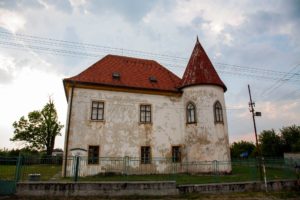Appony

Appony (Oponice) can be found in Slovakia, in the district of Nyitra, not far from Nagytapolcsány castle. The ruins of the castle of Appony are located north of Nyitra (Nitra), on the 333-meter-high southwestern slope of the main forested ridge of the Tribecs Mountains. Near the village stand the ruins of Appony Castle, dating back to the 13th century. In the village, there is a 16th-17th century Renaissance castle with the Apponyi library. You can find Appony on my Google Maps:

Photo: Szegedi Szabolcs
Appony Castle was built by the Csák Clan in the second half of the 13th century. The first mention of it dates back to 1300 when it was owned by Master Csák. The charter mentions Master Csák’s castellan of Appony, Bálint, the son of Bogyoszló, a nobleman of Nádas (Valentino filio Buguzlay nobili de Nadas nunc castellano magistri Chaak de castro Oponh). After the death of Master Csák, the castle was inherited by his brother Csák Máté.

This early fortress consisted of a cylindrical tower, 8.5-8.9 meters in diameter and about 20 meters high, with a tapering edge towards the attackable side. It was surrounded by a small curved stone wall.
After the death of the infamous lord of Trencsény (Csák Máté), not waiting for the army of King Károly Róbert, Miklós, the son of Amadeus of Gutkeled Clan, along with the army of the Archbishop Miklós of Sopron, invaded the oligarch’s territory and captured four castles, including Appony and Bajmóc. The king issued a document in Temesvár on 19 May 1321 in which he gave the villages of Vgroch and Ozlyan to János, son of Márkus in return for his loyalty in retaking the castle of Opon [Appony]. Thus, Appony became a royal castle until 1392.

www.varlexikon.hu
We know about a castellan of Apony called Kenéz who was accused of masterfulness by Mátyás of Elephant in 1325. In 1389, King Zsigmond stayed in Appony for an extended period. At that time he pledged it to Kaplai Dezső for 1000 Forints. On 26 March 1392, King Zsigmond ceded the royal castle of Appony with the estates of Kovarcz and Lehota, as well as Pereszlény and Körtvélyes, which he had annexed to the castle of Appony, to the children of Cseklészi Miklós, namely Eőri Péterné (a woman who had equal rights with a man), Thuróczi Benedekné (another woman who had equal rights with a man), and Vesszős Tamás.

www.varlexikon.hu
On 21 April 1395, the property of Cseklész was divided between Eőri Péter, Thuróczi Benedek, and Vesszős Tamás, who had become a widower in the meantime. After the division, the castle of Appony with the annexed parts went to Eőri Péter and his sons Tamás and Miklós. In 1396, Eőri Tamás acquired the right to hold weekly markets in Appony.

www.varlexikon.hu
In the document issued by the Pécs Chapter dated 23 November 1411, Eőri Péter and Tamás were first mentioned as Apponyi (“de Apon”). In 1430, the Bohemian Hussites, who invaded the countryside, briefly occupied it. The castle was damaged in the fighting. The first major construction work was carried out at this time: a new stone wall was built around the castle core.

www.varlexikon.hu
In 1450, the men of Apponyi Péter’s cousin, Apponyi László, were driven out of Apponyi Castle. His documents and valuables were taken away, causing a damage of 2000 Forints. Péter, the violent cousin was a brave soldier and fought numerous times with the Turks and the raiding Czechs under the command of Hunyadi János.

In 1488, the members of the family were in dispute with each other: the Chapter of Nyitra reported to King Matthias that Apponyi Anglis could not be registered in the parts of Apponyi Castle and its appurtenances that he inherited from his late father Apponyi Tamás because of the opposition of Apponyi Ambrus.

In 1514, Ludányi Rafael and his wife Anna, the wife of Jabloniczi Cseh János, attacked the castle of Peter Apponyi Péter with armed men, from which they stole many documents, 200 gold Forints, and silver coins, the value of which the complainant estimated at ten thousand gold Forints. The objects were found in the castle of Ludányi during the investigation, together with other stolen objects. However, the very high estimated value was reduced to 400 gold pieces. In 1517, King Lajos (Louis) II granted Apponyi Péter and his relatives (Móricz, Miklós, Ferenc, and Benedek) a new grant of Appony Castle and its appurtenances.

Photo: Szegedi Szabolcs
In the 16th century, Appony’s manor was one of the smaller ones, only 3 villages belonged to it: Appony, Sipkó, and Vágőr with 116 houses (homesteads). In 1542, the castle was fortified due to the Turkish threat. At that time, the cylindrical cannon tower called ‘Teres’ was built.

The greatest changes in the life of the castle came with the rebuilding which took place in the early 17th century. A new palace building was constructed in the north-eastern part of the outer courtyard and the cannon turret was converted into a residential building. The castle wing was also built. The reconstruction also affected the medieval core of the castle, where a new late Renaissance-style building was added.

www.varlexikon.hu
The Apponyi family had land disputes, so in 1612 two Renaissance palaces were built in the village. Work on the castle was interrupted and the cramped fortress was used only as a defense until 1645, when it burned down because of a lightning strike. The castle was then abandoned for good, and without a roof, it fell into disrepair.

www.varlexikon.hu
In 1708, at the time of the Rákóczi War of Independence, the ruins were still used as a hiding place by the Kuruc soldiers. At that time, the Imperial troops fired cannons at them, and even the standing parts were badly damaged. The castle was surveyed by Könyöki József in 1888. Its conservation and excavation started in 2015 and is still ongoing (2022).

www.varlexikon.hu
Source: http://www.varlexikon.hu
Video: https://www.youtube.com/watch?v=N6gonjUb6B0
Dear Readers, I can only make this content available through small donations or by selling my books or T-shirts.































